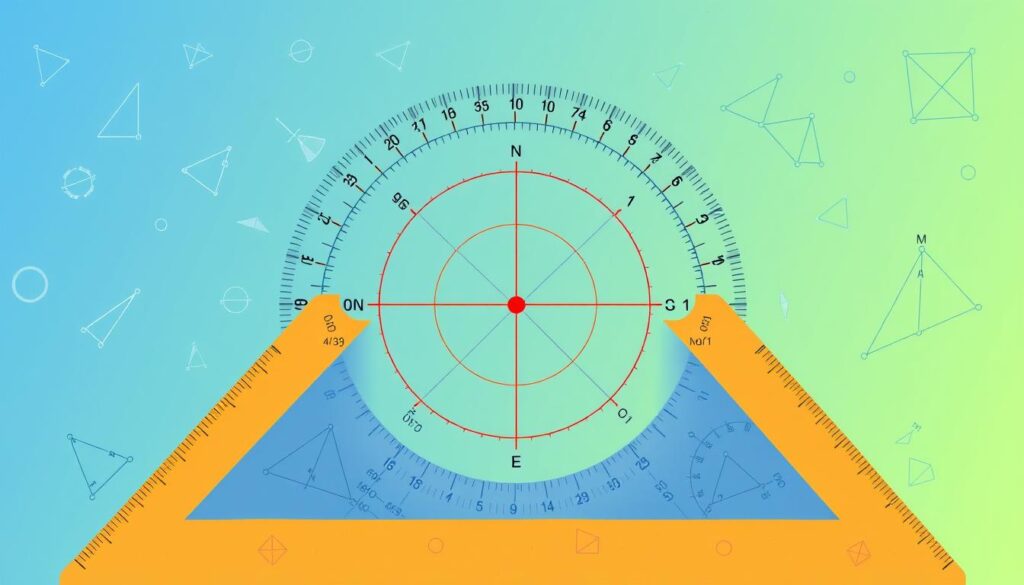Angular conversion is key in math and science. It’s vital for solving trigonometry problems and complex physics calculations. This guide will help you master degree to radian transformations.
Converting angles might seem tough, but it’s easy with the right approach. A circle has 360 degrees. Radians are another way to measure angles1.
Radians measure the distance around a circle’s edge. They’re based on the ratio of arc length to radius1. This method offers a more natural way to measure rotational motion.
Key Takeaways
- Learn the fundamental conversion between degrees and radians
- Understand the practical applications in mathematics and physics
- Master the simple conversion formula
- Recognize the importance of angle measurement in scientific calculations
- Develop skills for advanced trigonometric problem-solving
Understanding Degrees and Radians
Measuring angles is key in math. It helps us grasp trigonometric functions and the unit circle. Knowing how to measure angles is vital for solving equations and exploring geometry.
What Are Degrees?
Degrees are a common way to measure angles. A full circle has 360 equal parts, each being one degree2.
This system came from ancient times. It’s still used in navigation, astronomy, and basic geometry3.
- One full rotation = 360 degrees
- One degree can be subdivided into 60 minutes
- One minute can be further divided into 60 seconds
What Are Radians?
Radians offer a mathematical way to measure angles. They’re based on a circle’s radius. One radian is the angle when arc length equals circle radius3.
In mathematics, radians reveal the elegant simplicity of circular measurements.
Differences Between Degrees and Radians
| Characteristic | Degrees | Radians |
|---|---|---|
| Full Circle | 360° | 2π radians |
| Conversion Factor | π/180° | 180°/π |
| Preferred Use | Everyday Measurements | Advanced Mathematics |
Degrees are easy to understand. But radians are better for advanced math. They show angular relationships more naturally23.
The Conversion Formula You Need
Grasping the radians formula is key for working with periodic functions and math constants. It helps you master angle conversions. This skill can open up new ways to think about math relationships.
The Basic Conversion Formula
Converting degrees to radians uses a simple yet powerful formula. It’s radians = degrees × (π/180)4. This method lets you quickly change angle measurements5.
- Standard conversion: multiply degrees by π/180
- Alternative method: multiply degrees by 0.0174534
How to Use the Formula in Practice
Let’s break down the conversion process step by step:
- Take your angle in degrees
- Multiply by π/180
- Simplify the result if possible
Example Conversions
- 30 degrees = π/6 radians5
- 45 degrees = π/4 radians6
- 90 degrees = π/2 radians6
- 180 degrees = π radians6
Pro tip: Remember that 1 radian is approximately 57.29578 degrees4.
Periodic functions rely heavily on these conversions. The radians formula offers a standard way to measure angles. It’s useful in many math contexts6.
Quick Reference: Common Degrees to Radians
Special angles are key in circular motion and angle measurement. The unit circle helps convert degrees to radians easily and accurately. Knowing these angles will boost your math skills7.
Essential Angle Conversions
Knowing specific angle conversions simplifies trigonometric calculations. Here are the most important special angles:
Comprehensive Conversion Reference
Here’s a handy chart to make your angle calculations easier:
| Degrees | Radians |
|---|---|
| 0° | 0 |
| 30° | π/6 |
| 45° | π/4 |
| 60° | π/3 |
| 90° | π/2 |
| 120° | 2π/3 |
| 180° | π |
| 270° | 3π/2 |
| 360° | 2π |
Pro tip: Practice these conversions often. It’ll boost your skills in circular motion and angle measurement7.
Tips for Practicing Degree to Radian Conversions
Mastering angular conversion takes regular practice and smart learning strategies. Start with simple trigonometric functions and gradually tackle more complex math problems. Online platforms like Khan Academy offer great resources for honing your conversion skills.
Focus on the core conversion formula: multiply degrees by π/18010. Use online calculators to verify your work. The conversion process becomes easier with practice, helping you recognize common angle measurements quickly.
Avoid common mistakes during angular conversion. Always include π in your final answer. Double-check your fraction calculations carefully. Practice with various angle measurements, including negative and large degree values.
Try converting challenging angles like 700° or 450°. This can significantly boost your math skills10. Remember, mastering these conversions takes time and effort.
Use different learning resources to improve your skills. Solve a variety of problems to build confidence. Challenge yourself with complex trigonometric functions to become a math whiz.
FAQ
What’s the difference between degrees and radians?
How do I convert degrees to radians?
What are some common degree to radian conversions I should know?
Why do mathematicians prefer radians over degrees?
Are there any tools to help me practice degree to radian conversions?
What are the most common mistakes when converting degrees to radians?
How is understanding radians useful in real-world applications?
Source Links
- Intuitive Guide to Angles, Degrees and Radians – https://betterexplained.com/articles/intuitive-guide-to-angles-degrees-and-radians/
- Differences Between Radian and Degree – https://unacademy.com/content/ssc/study-material/mathematics/differences-between-radian-and-degree/
- 19.2.1: Degree and Radian Measure – https://math.libretexts.org/Bookshelves/Applied_Mathematics/Developmental_Math_(NROC)/19:_Trigonometry/19.02:_Graphing_Trigonometric_Functions/19.2.01:_Degree_and_Radian_Measure
- Degrees to Radians Conversion (° to rad) – Inch Calculator – https://www.inchcalculator.com/convert/degree-to-radian/
- How to Convert Degrees to Radians: 5 Steps (with Pictures) – https://www.wikihow.com/Convert-Degrees-to-Radians
- Degrees to Radians Calculator | Conversion, Formula & Solved Examples – GeeksforGeeks – https://www.geeksforgeeks.org/degrees-to-radians/
- 4.1: Radians and Degrees – https://math.libretexts.org/Bookshelves/Precalculus/Elementary_Trigonometry_(Corral)/04:_Radian_Measure/4.01:_Radians_and_Degrees
- Converting Degrees to Radians: A Quick Guide – https://www.physicsforums.com/threads/converting-degrees-to-radians-a-quick-guide.481054/
- Degree to Radian Measure – https://www.varsitytutors.com/hotmath/hotmath_help/topics/degree-to-radian-measure
- Degrees to Radians – Conversion and Solved Examples – https://www.vedantu.com/maths/degrees-to-radians
